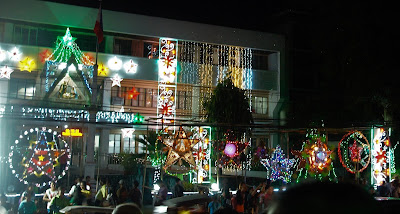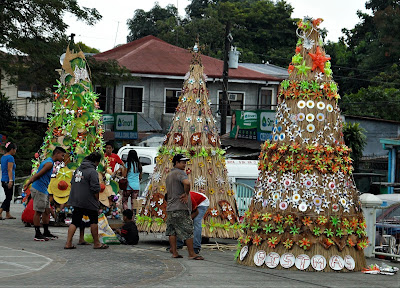Republic Act 10966 "declaring December 8 of every year a special nonworking holiday in the entire country to commemorate the feast of the Immaculate Conception of Mary, the principal patroness of the Philippines," was approved by President Rodrigo Roa Duterte on 28 December 2017.
This Act originated from the House of Representatives was passed by the House and the Senate on 02 May 2017 and 11 December 2017, respectively. A copy has been posted on the online version of the print edition of the Official Gazette (see picture below).
 |
| RA 10966 as posted on the Official Gazette webpage. http://www.officialgazette.gov.ph/downloads/2017/12dec/20171228-RA-10966-RRD.pdf |
This will make twenty-one (21) national, regular and special (non-working) holidays to be observed in the country this coming year, 2018. Twenty were listed in Proclamation No, 269 that Duterte issued on 17 July 2017.
Some of these fall on weekends: 25 February (EDSA People Power Revolution Anniversary), 31 March (Black Saturday), and 30 December (Rizal Day).
Two dates have yet to be set for the observance of national holidays Eidul Fitr and Eidul Adha, which depends on the Islamic calendar.
RA 10966, in a way, revisits legal and school holidays of Philippine past.
The feast of the Immaculate Conception was not in the school holidays prescribed by the Royal Decree of 20 December 1863, which created the "normal school for teachers of primary instruction for the natives of the Filipinas Islands," but there were other religious feast days included.
The decree provided that "the holidays of the normal school shall be Sundays, feast
days, Ash Wednesday, the day set aside for the commemoration of
the faithful dead, and also the saint's days and birthday anniversaries
of their Majesties and the prince of Asturias, and the saint's
day of the superior civil governor," and "the
shorter vacations shall extend from Christmas eve to Twelfth-night, during
the three carnival days, and from Holy Wednesday until Easter.
During said vacations, the resident scholars shall remain in the
institution."
When the Americans set up the school system, the schools were allowed fourteen weeks' vacation each year, two of which were the usual Christmas break. In addition to these regular vacations, an Act from the United States Philippine Commission established the following holidays in 1902:
New
Year's Day - January 1.
Washington's
Birthday -February 22.
Holy
Thursday - March 27.
Good
Friday - March 28.
Independence
Day -July 4.
Occupation
Day - August 13.
Thanksgiving
Day - November 27.
Christmas Day -December
25.
Rizal
Day - December 30.
In
addition, the following church fiestas may be observed as holidays by the schools:
Epiphany,
or Three Kings' Day -. January 6.
Purification
of the Blessed Virgin -February 2.
Ascension
Day -May 11.
Corpus
Christi Day -June 1.
Assumption
Day -August 15.
All
Saints' Day -November 1.
Conception
of the Blessed Virgin Mary -December 8.
However, in a proclamation of the General Superintendent of schools on 10 August 1904, the feast of the Immaculate Conception was not included in the "second holidays" for public schools. It retained the Marian event of 02 February, and the patron saint's day of the town was added.
The 1904 listing comprised the Epiphany or Three Kings, January 6; Purification of the Blessed Virgin, February 2; Ascension Day, May 1; Corpus Christi; Assumption Day, August 15; All Saints' Day, November 1; patron saint of the pueblo, one day only.
The women who went to Catholic schools for girls do remember that the feast of the Immaculate Conception was no-classes day. Thus, they were excited when they first heard that a law declaring this a holiday was under discussion in the Seventeenth Congress.
The 1904 listing comprised the Epiphany or Three Kings, January 6; Purification of the Blessed Virgin, February 2; Ascension Day, May 1; Corpus Christi; Assumption Day, August 15; All Saints' Day, November 1; patron saint of the pueblo, one day only.
The women who went to Catholic schools for girls do remember that the feast of the Immaculate Conception was no-classes day. Thus, they were excited when they first heard that a law declaring this a holiday was under discussion in the Seventeenth Congress.
References:
- Blair & Robertson. 1906. Royal Decree establishing a plan of primary education in Filipinas. Appendix: Education in the Philippines. The Philippine Islands, 1493-1898; Volume XLVI, 1721-1739. http://name.umdl.umich.edu/AFK2830.0001.046.
- Atkinson, Fred W. The Present Educational Movement in the Philippine Islands. Chapter XXIX. Report of the Commissioner on Education For 1900-1901. Washington: Govt. Printing Office. 1902. http://name.umdl.umich.edu/ahk8492.0001.001
- Philippine Civil Service Board. Calendar 1904-1905. Manual of Information relative to the Philippine Civil Service. Manila: Bureau of Public Printing. 1904. Page 3. http://name.umdl.umich.edu/acf2655.1903.001
- Department of Public Instruction. Bureau of Education. Appendix H. Some of the circulars of the General Superintendent. Annual Report of the General Superintendent of Education. September 1904. Manila: Bureau of Public Printing, 1904. Page 97. http://name.umdl.umich.edu/acs9512.1904.001.
- The Government of the Philippine Islands. Dept. of Public Instruction. Bureau of Education. Appendix E. School Calendar. Seventeenth Annual Report of the Director of Education. January 1, 1916 to December 31, 1916. Manila: Bureau of Printing, 1917. Page 129. http://name.umdl.umich.edu/acs9512.0001.017
- Fifteenth Year Rosenstock’s Manila City Directory 1917. Vol XXIII. Page 143. http://name.umdl.umich.edu/acs9103.0001.001
- Legal Holidays. Manila and the Philippines. American Express. Page 102. 1933? http://name.umdl.umich.edu/ahz9173.0001.001

